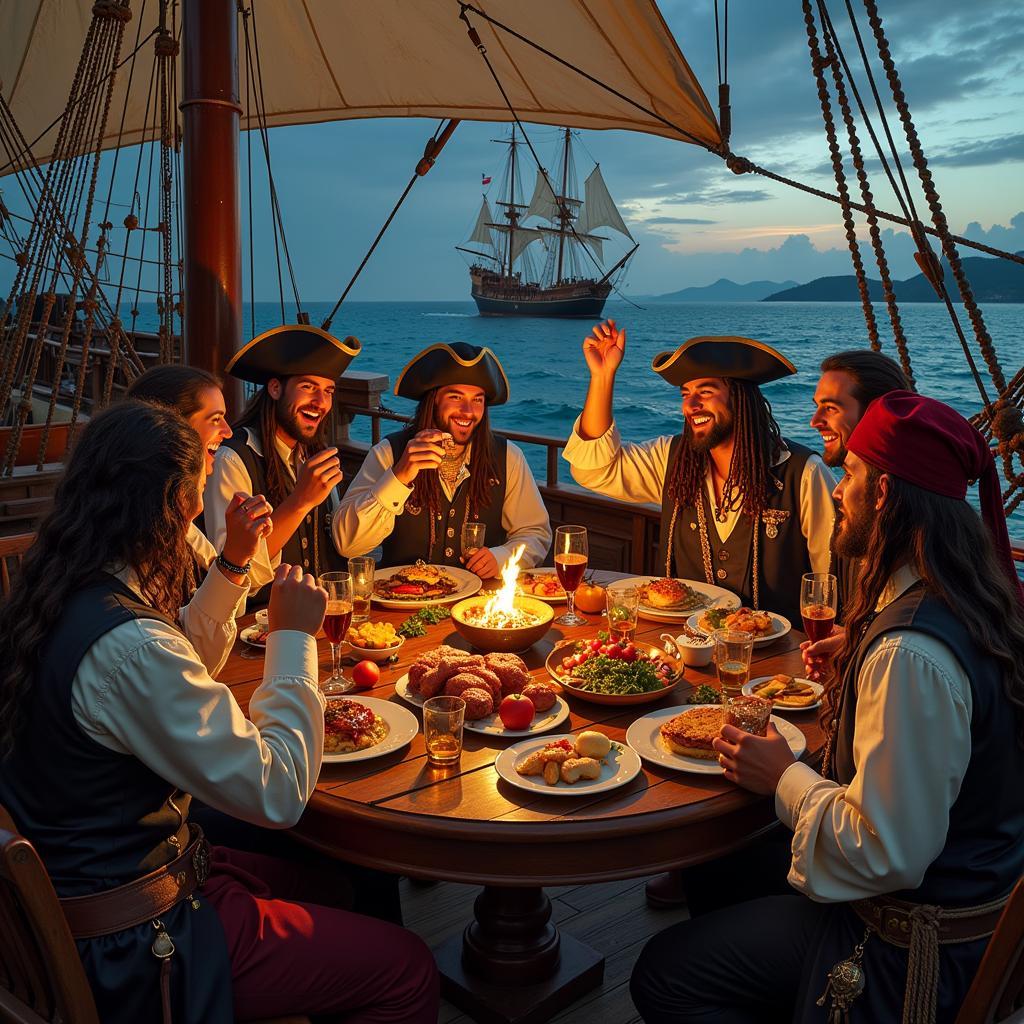Unveiling the Mystery: What is the Feast of the Pirates?
October 11, 2024The phrase “Feast Of The Pirates” might evoke images of swashbuckling buccaneers gathered around a table piled high with plundered treasure and exotic foods. While the reality might not be as extravagant, the historical and cultural significance of feasts within pirate communities is a fascinating journey into a world governed by its own unique set of rules and traditions.
More Than Just Grub: The Significance of Feasts in Pirate Life
Life on the high seas was harsh and unpredictable. Pirates, often escaping poverty or seeking fortune, lived outside the bounds of conventional society. In this environment, a shared meal represented more than sustenance; it was a vital tool for building camaraderie, establishing hierarchy, and maintaining order amidst the chaos.
 Pirates celebrating with a feast
Pirates celebrating with a feast
Rules of the Pirate Round Table: Codes of Conduct and Rituals
While a “feast of the pirates” might sound like a free-for-all, these gatherings were often governed by strict codes of conduct. Pirate articles, agreed upon by the crew, often outlined rules for behavior during feasts. Disputes, often fueled by rum, were common, but transgressions against the established order could result in severe punishments.
What Was on the Menu? Pirate Cuisine and Culinary Delights
Forget Hollywood’s depiction of endless roast meat. The reality of a pirate’s diet was often far less appealing. While a successful raid might yield fresh meat, fruits, and vegetables, the staple diet often consisted of preserved foods like salted meat, ship’s biscuits, and whatever could be foraged or fished at sea.
 Cooking in the galley of a pirate ship
Cooking in the galley of a pirate ship
Beyond the Bounty: The Feast as a Symbol of Freedom and Rebellion
For pirates, the act of feasting held deeper meaning. It was a rejection of the constraints and hierarchies of the societies they had left behind. Aboard their ships, under their own laws, pirates found a sense of freedom and equality, even if fleeting, that was reflected in the communal nature of their feasts.
Feast or Famine: The Unpredictable Nature of Pirate Life
The frequency and lavishness of a “feast of the pirates” depended heavily on the success of their raids. Long stretches at sea with dwindling supplies were a constant threat. Therefore, the opportunity to feast was not taken for granted and served as a powerful reminder of the precarious nature of their existence.
FAQs
Q: Did pirates really bury treasure?
A: While some pirates did bury treasure, it was less common than popular culture suggests. The practice was often a matter of necessity, allowing pirates to hide valuables in case they needed to recover them later.
Q: Were all pirates men?
A: While most pirates were men, there’s evidence of women who disguised themselves as men to join pirate crews or who even captained their own ships.
 A female pirate captain commanding her crew
A female pirate captain commanding her crew
From the Desk of Captain Jack Sparrow (a fictional expert)
“A pirate’s life is full of risk and reward, and there’s no better way to celebrate a victory than with a proper feast. But remember, mates, even in the midst of merriment, a true pirate always keeps one eye on the horizon, for the seas are fickle and fortune can change with the tide.”
If you need help understanding more about the “feast of the pirates” or other aspects of maritime history, don’t hesitate to reach out. Contact us at Phone Number: 0963418788, Email: [email protected] Or visit us at: 2M4H+PMH, Nghĩa Thành Ward, Gia Nghĩa, Đắk Nông, Vietnam. We have a 24/7 customer support team.